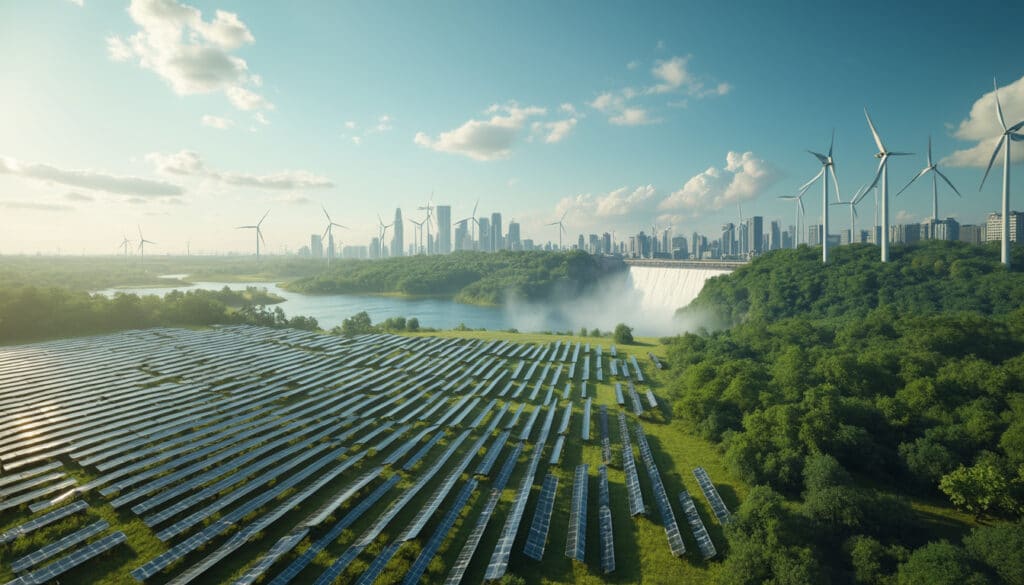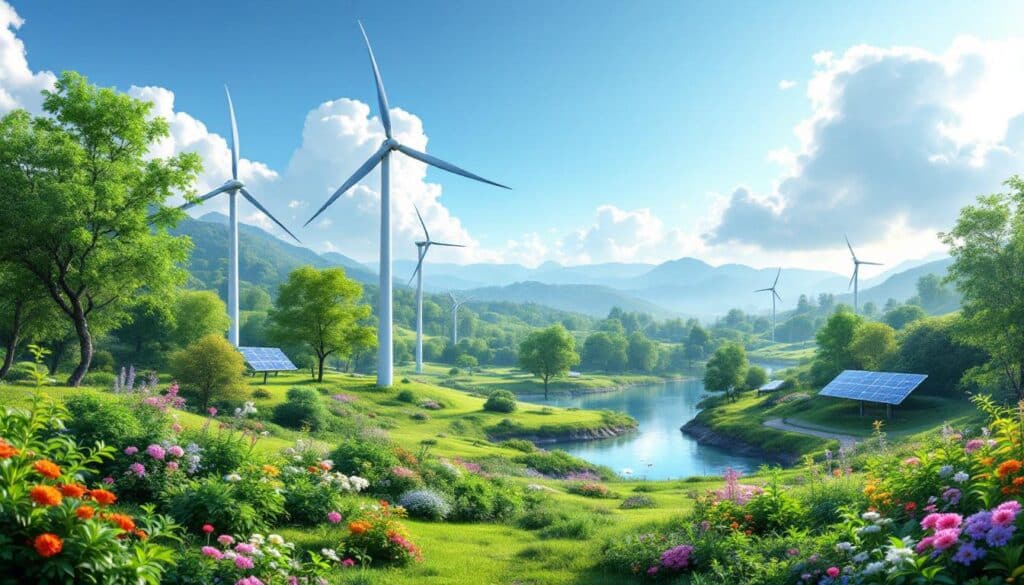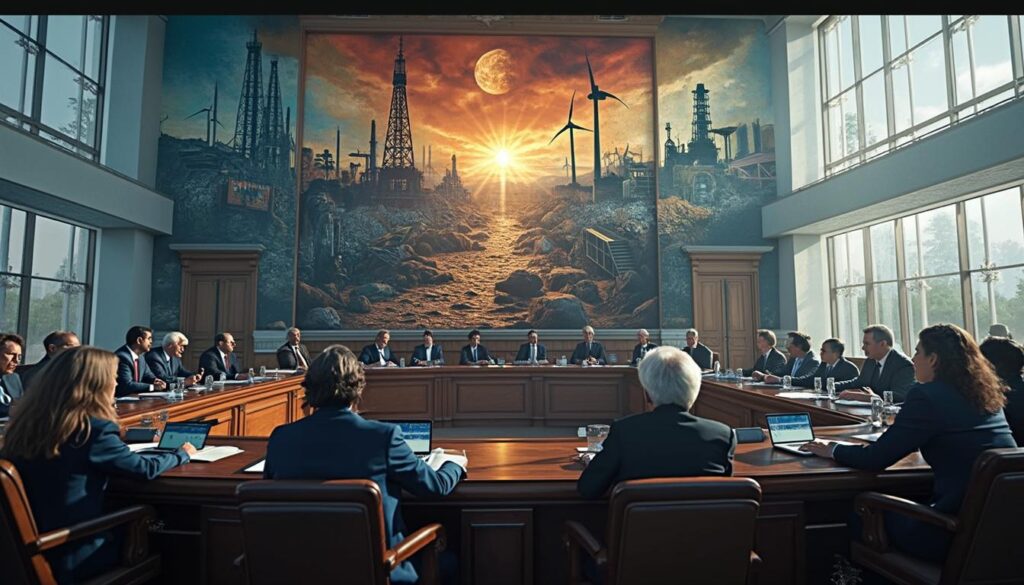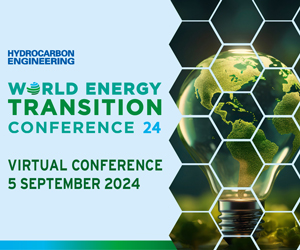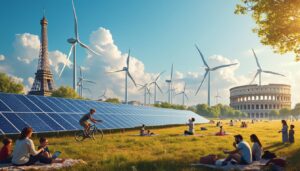In 2024, global renewable energy capacity registered a record annual growth of 15.1%.This increase added 585 gigawatts to the sector.In total, the installed capacity now reaches 4,448 gigawatts.
Despite this impressive progress, experts emphasize that the current pace is still below the targets necessary to triple capacity by 2030. To reach this ambition, an annual expansion of 16.6% is required. Renewables sources dominate the growth of international energy supply, accounting for 38% of new installations in 2024. This dynamism is primarily driven by photovoltaic solar, which constitutes about 80% of the new capacities added.
record growth of renewable energy capacity in 2024
In 2024, global renewable energy capacity experienced an unprecedented increase of 585 gigawatts, thus establishing a new annual record. According to the International Renewable Energy Agency (IRENA), this growth represents an increase of 15.1% compared to the previous year. With this addition, the total installed capacity in the renewable energy sector now reaches 4,448 gigawatts. This advancement underscores the global commitment to energy transition and the reduction of greenhouse gas emissions.
This record growth was primarily driven by a significant expansion of solar and wind energy, which together contributed to nearly 96.6% of new installations. Notably, photovoltaic solar energy dominated with an increase of nearly 80% in its installed capacity, demonstrating the maturity and growing competitiveness of this technology in the global market. Moreover, wind energy also recorded an increase of 11.1%, driven by massive investments in onshore and offshore projects.
what are the main booming renewable energy sources?
The renewable energy sources that most contributed to the 2024 increase are solar energy and wind energy. Solar photovoltaics recorded impressive growth, adding approximately 700 gigawatts of additional capacity, of which nearly 80% comes from solar. This expansion is driven by technological innovations, decreasing production costs, and government policies favorable to investment in renewables.
Wind energy, for its part, reached a total capacity of 1,133 gigawatts in 2024, thanks to major developments in the United States and China. These two countries have played a major role by injecting substantial investments into onshore and offshore wind farms, which now benefit from better integration into the global electricity grid.
In addition to solar and wind, other sources like hydropower and bioenergy also contributed to this growth. For example, hydropower has rebounded to reach a capacity of 1,283 gigawatts, mainly due to projects in China. Bioenergy has also progressed, with an expansion of 4.6 gigawatts, supported by initiatives in China and France.
what are the challenges to meet IRENA’s goals by 2030?
Despite this remarkable growth, IRENA emphasizes that the current pace is insufficient to meet the targets set for 2030. The organization estimates that an annual expansion of 16.6% would be needed to get closer to the goal of tripling the installed capacity of renewable energy by the end of the decade. Currently, the growth of 15.1% in 2024 leaves a significant deficit compared to the 11.2 terawatts needed annually.
One of the main challenges lies in the need to overcome regional disparities in renewable energy development. Some regions, particularly in the Global South, struggle to attract investment and establish the necessary infrastructures. REN21 has highlighted that without stronger international collaboration, these disparities could hinder the global adoption of renewables.
Moreover, IRENA underscores the importance of enhancing grid flexibility to effectively integrate the variable energy produced by solar and wind. This requires investments in energy storage technologies and smart management systems to ensure a stable and reliable electricity distribution.
IRENA’s Director-General, Francesco La Camera, also calls for a clarification of renewable ambitions in the upcoming Nationally Determined Contributions (NDCs), to provide a clear roadmap for governments and investors.
what economic impact do renewables have on global markets?
The expansion of renewable energy opens numerous economic opportunities worldwide. According to the International Energy Agency (IEA), renewables were the main drivers of international supply growth in 2024, accounting for 38% of this increase, surpassing natural gas (28%) and coal (15%). This dynamic reflects the growing attractiveness of clean and sustainable technologies for investors.
The expansion of renewables also generates jobs in various sectors, from solar panel manufacturing to wind farm construction. According to studies, each gigawatt of installed renewable capacity creates hundreds of direct and indirect jobs, thus stimulating local and national economies. Additionally, the reduction of renewable energy costs contributes to lowering long-term electricity bills, although recent increases in energy bills may temporarily complicate this landscape.
Renewable energy also contributes to strengthening the energy security of nations by reducing their dependence on fossil fuel imports. This increased independence allows countries to better control their energy supplies and stabilize their economies in the face of fluctuations in oil and gas prices.
However, to maximize these economic benefits, it is essential to maintain robust supportive policies and continue investing in technological innovation. Furthermore, renewable energy completion certificates play a crucial role in encouraging businesses to adopt clean energy sources, thereby strengthening the renewable market.
what is the position of international leaders regarding the expansion of renewables?
Global leaders play a decisive role in accelerating the energy transition. At the opening ceremony of the annual climate summit of the United Nations in November, Mukhtar Babayev, president of COP29, stressed the importance of increased financing to support climate efforts. He urged governments, the private sector, and multilateral financial institutions to collaborate closely to achieve the goals of the Paris Agreement, which aims to limit global temperature rise to 1.5 degrees Celsius above pre-industrial levels.
IRENA’s Director-General, Francesco La Camera, also called for the upcoming NDCs to provide a clear roadmap for renewable energy ambitions. He stressed that without concerted action and ambitious commitments, it will be difficult to maintain the necessary trajectory to achieve emission reduction targets.
Moreover, government policies play a crucial role in creating a conducive environment for investments in renewables. Initiatives such as subsidies, tax incentives, and favorable regulations can stimulate the adoption of green technologies. In some countries, such as Uruguay, anenergy revolution is underway, showing how well-structured policies can transform the energy landscape and serve as a model for other nations.
However, challenges remain, including the management of internal political tensions as illustrated by political disputes that can hinder progress on renewable initiatives. Stability and consistency in policies are crucial to maintaining investor confidence and ensuring the continuity of long-term projects.
how are technological innovations shaping the future of renewables?
Technological innovations play a central role in the growth dynamics of renewable energies. Advances in photovoltaic solar energy, for example, have significantly improved the efficiency of solar panels while reducing their production costs. This trend has enabled broader adoption and made solar competitive with traditional energy sources.
In the wind sector, new technologies allow for the design of larger and more efficient turbines capable of capturing more energy even at moderate wind speeds. Additionally, the development of offshore wind opens up unprecedented opportunities to harness more abundant and consistent wind resources.
Energy storage technologies are also crucial for overcoming the variability of solar and wind energies. Lithium-ion batteries and advanced storage solutions can store excess energy produced during high production periods for reinjection into the grid during peak demand. This improves the stability and reliability of renewable energy systems.
Furthermore, the integration of smart management systems and artificial intelligence (AI) optimizes energy distribution and infrastructure maintenance. These technologies enable better forecasting of renewable energy production, more effective resource management, and reduced operational costs.
Finally, innovations in materials and manufacturing processes contribute to making renewable technologies more sustainable and efficient. For example, research on advanced materials for solar panels promises to increase their lifespan and energy yield.
what are the future prospects for renewables globally?
The prospects for renewable energies remain extremely promising, with an upward trend expected to continue over the next decade. However, the ambitious goal of IRENA to triple the installed capacity of renewables by 2030 requires sustained efforts and enhanced international collaboration.
Investments in renewable infrastructure are expected to continue rising, supported by growing global demand for clean and sustainable energy sources. The ongoing decline in costs for solar and wind technologies, combined with robust supportive policies, should encourage more countries to adopt these energies.
The expansion of storage capacities and improvement of electrical grid flexibility will facilitate the integration of renewables into existing energy systems, thus increasing their share in the global energy mix. Moreover, innovations in carbon capture and storage technologies may also play a complementary role in combating climate change.
The development of emerging markets in renewables, particularly in Asia, Africa, and Latin America, is also a key factor. These regions have enormous potential for solar and wind energy, and with adequate support, they could become global leaders in clean energy production.
Finally, the growing public awareness and demand for sustainable energy solutions will continue to drive initiatives in favor of renewables. Corporate and government commitments to reduce their carbon footprint and promote sustainable practices will reinforce the energy transition towards a greener future.
Articles similaires
Thank you!
We will contact you soon.

